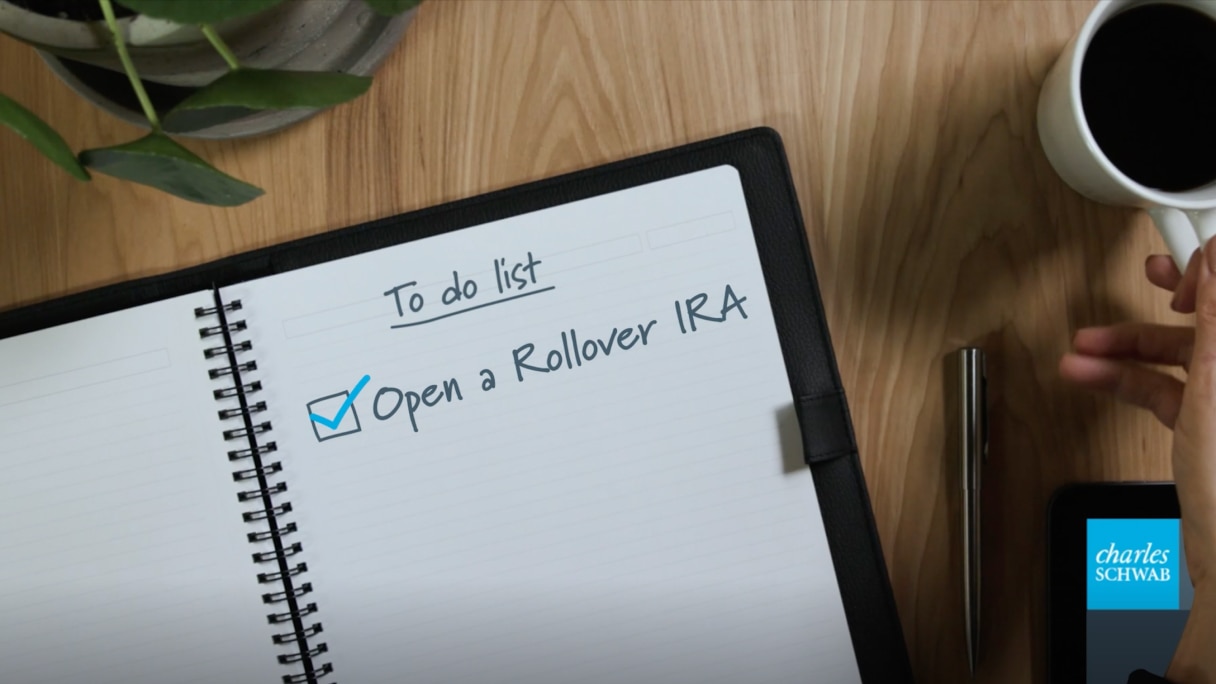
One way to take control of your retirement savings is to roll over your prior retirement plan from a former employer.


Upbeat music plays throughout
Video Introduction Plays
Narrator: Looking to consolidate prior workplace retirement accounts into a Schwab Rollover IRA?
Screen fades to Schwab Homepage
Narrator: A Rollover IRA is an account that allows you to move funds from your prior employer-sponsored retirement plan into an IRA. To begin this process, navigate over to Accounts, and click Retirement under Open an Account.
Mouse clicks Accounts and clicks on Retirement.
Narrator: Before we continue, it's important to understand the source of funds in your employer-sponsored plan. Your plan may contain a mix of pre-tax, post-tax and Roth contributions. To identify your options, we recommend you speak with your prior plan sponsor or a tax advisor. No matter which account type is right for you, you'll need to continue by clicking the start button found directly to the right of the appropriate account summary. For this example, we'll continue with the Rollover IRA.
Mouse clicks on Start button to the right of Rollover IRA.
Narrator: Next, you'll need to complete the guided walkthrough. During this process, you'll need to provide personal details, select account features and review the account terms and conditions. This process only takes about 10 minutes. As soon as you open your account, you'll be asked to choose your funding preference. To complete this process, you'll need to choose between one of two funding options available to you: Direct Rollover and Indirect Rollover. A direct rollover requires your prior plan administrator to send a check directly to Charles Schwab, thereby depositing funds to your account directly. Conversely, to complete an indirect rollover, you'll need your prior plan provider to directly issue you a check, which you can then deposit into your newly created Rollover IRA. It's important to note that Indirect Rollovers can often carry tax implications and incur penalties if not handled correctly.
Video outro plays.
Close modal Video TranscriptUpbeat music plays throughout
Video Introduction Plays
Narrator: Looking to consolidate prior workplace retirement accounts into a Schwab Rollover IRA?
Screen fades to Schwab Homepage
Narrator: A Rollover IRA is an account that allows you to move funds from your prior employer-sponsored retirement plan into an IRA. To begin this process, navigate over to Accounts, and click Retirement under Open an Account.
Mouse clicks Accounts and clicks on Retirement.
Narrator: Before we continue, it's important to understand the source of funds in your employer-sponsored plan. Your plan may contain a mix of pre-tax, post-tax and Roth contributions. To identify your options, we recommend you speak with your prior plan sponsor or a tax advisor. No matter which account type is right for you, you'll need to continue by clicking the start button found directly to the right of the appropriate account summary. For this example, we'll continue with the Rollover IRA.
Mouse clicks on Start button to the right of Rollover IRA.
Narrator: Next, you'll need to complete the guided walkthrough. During this process, you'll need to provide personal details, select account features and review the account terms and conditions. This process only takes about 10 minutes. As soon as you open your account, you'll be asked to choose your funding preference. To complete this process, you'll need to choose between one of two funding options available to you: Direct Rollover and Indirect Rollover. A direct rollover requires your prior plan administrator to send a check directly to Charles Schwab, thereby depositing funds to your account directly. Conversely, to complete an indirect rollover, you'll need your prior plan provider to directly issue you a check, which you can then deposit into your newly created Rollover IRA. It's important to note that Indirect Rollovers can often carry tax implications and incur penalties if not handled correctly.